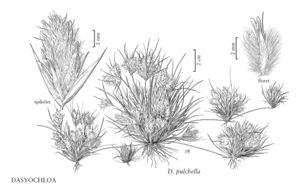Difference between revisions of "Dasyochloa pulchella"
FNA>Volume Importer |
FNA>Volume Importer |
||
| Line 8: | Line 8: | ||
|name=Triodia pulchella | |name=Triodia pulchella | ||
|authority=unknown | |authority=unknown | ||
| − | }}{{Treatment/ID/Synonym | + | }} {{Treatment/ID/Synonym |
|name=Tridens pulchellus | |name=Tridens pulchellus | ||
|authority=unknown | |authority=unknown | ||
| − | }}{{Treatment/ID/Synonym | + | }} {{Treatment/ID/Synonym |
|name=Erioneuron pulchellum | |name=Erioneuron pulchellum | ||
|authority=unknown | |authority=unknown | ||
| Line 26: | Line 26: | ||
-->{{Treatment/Body | -->{{Treatment/Body | ||
|distribution=Md.;Colo.;N.Mex.;Tex.;Utah;Calif.;Wyo.;Ariz.;Nev. | |distribution=Md.;Colo.;N.Mex.;Tex.;Utah;Calif.;Wyo.;Ariz.;Nev. | ||
| − | |discussion=<p>Dasyochloa pulchella grows in rocky soils of arid regions. It extends from the United States to central Mexico and is the most common grass in the Larrea-Flourensia scrub of the southwestern United States and adjacent Mexico.</p> | + | |discussion=<p><i>Dasyochloa pulchella</i> grows in rocky soils of arid regions. It extends from the United States to central Mexico and is the most common grass in the <i>Larrea</i>-<i>Flourensia</i> scrub of the southwestern United States and adjacent Mexico.</p> |
|tables= | |tables= | ||
|references= | |references= | ||
| Line 47: | Line 47: | ||
|publication year= | |publication year= | ||
|special status= | |special status= | ||
| − | |source xml=https://jpend@bitbucket.org/aafc-mbb/fna-data-curation.git/src/ | + | |source xml=https://jpend@bitbucket.org/aafc-mbb/fna-data-curation.git/src/8f726806613d60c220dc4493de13607dd3150896/coarse_grained_fna_xml/V25/V25_74.xml |
|subfamily=Poaceae subfam. Chloridoideae | |subfamily=Poaceae subfam. Chloridoideae | ||
|tribe=Poaceae tribe Cynodonteae | |tribe=Poaceae tribe Cynodonteae | ||
Revision as of 16:33, 18 September 2019
Culms (1)4-15 cm, scabrous or puberulent; peduncles (internode below the panicles) 3-7(11) cm. Sheaths striate, margins scarious; ligules 3-5 mm; blades (1)2-6 cm, abaxial surfaces scabrous, adaxial surfaces scabridulous. Panicles 1-2.5 cm long, 1-1.5 cm wide, densely white-pubescent, light green or purple-tinged. Spikelets (5)6-9(10) mm, with (4)6-10 florets. Lower glumes 6-8.5 mm; upper glumes 6.5-9 mm, as long as or longer than the florets; lemmas 3-5.5 mm, lobes (1)3-3.2 mm, midveins extending into straight (1.5)2.5-4 mm awns; paleas 2-3.5 mm, keels long pilose proximally, ciliate distally; anthers 0.2-0.5 mm. Caryopses 1-1.5 mm, translucent. 2n = 16.
Distribution
Md., Colo., N.Mex., Tex., Utah, Calif., Wyo., Ariz., Nev.
Discussion
Dasyochloa pulchella grows in rocky soils of arid regions. It extends from the United States to central Mexico and is the most common grass in the Larrea-Flourensia scrub of the southwestern United States and adjacent Mexico.
Selected References
None.
